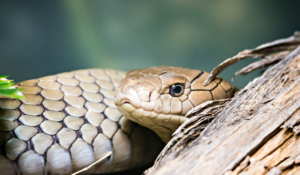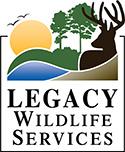
The Louisiana pine snake is a non-venomous constrictor. It is large, 4-5 feet long and pale tan in color with a row of large black or brown blotches down the back and sides.
Sexual maturity is reached at three years of age. The species has a gestation period of approximately 21 days, followed by 60 days of incubation. This species exhibits a relatively low reproductive rate with small clutch sizes of 3-5 eggs. This low fecundity increases other threats to the pine snake. Species with such low reproductive rates are typically less capable of recovering from events that affect population size, increasing their potential for local extirpations.
In studies in east Texas and west Louisiana, pine snakes spent a majority of their time below-ground, exhibiting only short-range movements. They were most active late-morning and mid-afternoon, and least active at night and early morning. Seasonally, Louisiana pine snakes were most active March-May and fall (especially November) and least active during hibernation in December-February, and in summer (especially August). Their below-ground refuges were almost exclusively pocket gopher burrow systems. Pocket gophers appear to be their primary food source, but other reported food items include other rodents, cottontails, amphibians, and ground-nesting birds and eggs.
Their annual home range varied from just a few acres up to several hundred acres in size and averaged around 100 acres. Adult males had larger home ranges than females. Males tended to make long moves in May-July, while females moved primarily in July-September.
The Louisiana pine snake is generally associated with sandy, well-drained soils in open pine forests. They are especially focused in longleaf-pine savannah with moderate to sparse mid-story and a well-developed herbaceous understory dominated by grasses.
The Bairds pocket gophers is an essential component of Louisiana pine snake habitat. They create the burrow systems in which the pine snakes are most frequently found and serve as a major source of food for the species. Snakes disturbed on the surface retreated to nearby burrows, and hibernation sites are always within burrows.
Pocket gopher abundance is dependent upon an abundance of herbaceous ground cover and loose, sandy soils. The amount of herbaceous vegetation is related to canopy cover. Generally, an early successional ground cover requires a high amount of sunlight penetration onto the forest floor. Pocket gopher abundance is associated with a low density of trees and an open canopy, which allowed greater sunlight, more understory growth, and better forage for pocket gophers.
Louisiana pine snakes originally occurred in at least 9 Louisiana parishes, coinciding with areas of longleaf pine ecosystem west of the Mississippi River. They are now found in only 4 Louisiana parishes. Most Louisiana records originate in Bienville Parish on privately owned forestland. A second population occurs on Federal lands in Vernon Parish.
Urban development, conversion to agriculture, road construction, and mining have all contributed to loss and fragmentation of pine snake habitat. However, the greatest impact to Louisiana pine snakes has been loss of the native longleaf and shortleaf-pine ecosystem. Louisiana pine snakes are also impacted by vehicle-caused mortality, both on state roads and on off-road trails. The Louisiana pine snake was formally listed with Federal protection under the Endangered Species Act in April of 2018.
A Candidate Conservation Agreement was developed and approved in order to identify and establish management protection for the pine snake in Louisiana by protecting known populations and habitat, reducing threats to its survival, maintaining its ecosystem, and restoring degraded habitat. This agreement was intended to establish a framework for cooperation and participation in the pine snake’s protection, conservation, and management. Restoration measures will include prescribed burning, thinning, and replanting of long-leaf pine forest.
Portions of the property managed by Legacy Wildlife Services are enrolled in a Conservation Management Agreement between the landowners, the Louisiana Department of Wildlife and Fisheries and the U.S. Fish and Wildlife Services. The Agreement is intended to promote good land stewardship through the implementation of conservation activities to benefit the Louisiana Pine Snake. Hunters and other individuals using this property are expected to abide by practices that promote the continued existence and or reestablishment of viable populations of the pines snake on the enrolled property.
General Property Rules For Pine Snake Protection Include:
- Gates must be locked at all times to restrict public access
- Off-road vehicle use should be minimized and limited to periods of low pine snake activity (December-February)
- Road travel should be limited to 5 mph slow-speed zones in pine snake areas
- Any pine snake road mortalities or accidental harvest must be reported to the Legacy Wildlife staff biologist immediately
- All structures, stands, feeders or food plots must be temporary and approved by Legacy Wildlife staff
- No soil tilling or harrowing is allowed
- Pine snakes are most often found within or near pocket gopher burrow systems, so no gopher burrows should be disturbed or destroyed
- Pine snakes are most active from March-May and September-November, live snake sightings should be reported to the Legacy Wildlife staff biologist
* Louisiana Department of Wildlife and Fisheries and the U.S. Fish and Wildlife Services data was used to develop this article and the hunt club best management practices.
Contact Jeff to learn more about wildlife management on your hunting lease property. Call 877-5-TO-HUNT, or submit our contact request form.
